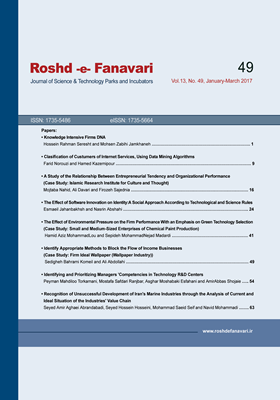Identifying and Prioritizing Managers’ Competencies in Technology R&D Centers
Subject Areas : Research and Development Managementpeyman mahdiloo torkamani 1 , Mostafa Safdari Ranjbar 2 , Asghar Moshabaki Esfahani 3 , amir abass Shojaei 4
1 -
2 - Allameh Tabataba’I University
3 -
4 -
Keywords: Managers Competencies Technology R&, D Centers Individual and Personality competencies Managerial and leadership competencies Technical and Professional Competencies Friedman Test ,
Abstract :
Nowadays the role of technology as a key factor in creating wealth and permanent competitive advantages in various levels has been proven. With due attention to the role of R&D centers in promoting firms’ technological capabilities, the management of these centers are extremely important. So, it is essential to present a framework in order to selecting new managers or extending the capabilities of current managers of these centers. In current study the concept of manager competencies and some previous frameworks in this area have been studied. Then, through holding a panel with 12 academic and industrial experts, the identified competencies were confirmed. Afterwards, 32 competencies were categorized in 3 categories: 1. Individual and personality competencies, 2. Managerial and leadership competencies, and 3. Technical and professional competencies. Finally, through inviting 62 executive managers who work in these centers, and introducing and explaining about identified competencies, a questionnaire was given to them. Via analyzing the questionnaires with Friedman test, each of the competencies and categories were prioritized. The results show, three competencies including: 1. Team work, communication and knowledge sharing, 2. Organizing and conducting research teams, and 3. Motivating and empowering experts and knowledge workers have higher priority than other identified competencies. Also, in terms of categorized competencies, individual and personal competencies have higher priority than other categories.
1- بابايي زکليلي، محمدعلي. طراحي نظام جامع توسعه مديران (تجربه در سازمان گسترش و نوسازي صنايع ايران). سومين کنفرانس توسعه منابع انساني. تهران: مؤسسه مطالعات و بهرهوري نيروي انساني، (1385).
2- جين، آر. کي. و تريانديس، اچ. سي. (1990). مديريت بر مديريت ناپذير (مديريت سازمانهاي تحقيقاتي). مترجمان: مهيار سرحدي و حسن محمدرضايي بيدگلي. انتشارت مؤسسه آموزشي و تحقيقاتي صنايع دفاعي، دفتر مطالعات و برنامهريزي استراتژيک (1381).
3- زاهدي، شمسالسادات و شيخ، ابراهيم. الگوي قابليتهاي راهبردي مديران مياني دولتي. مطالعات مديريت راهبردي، (1389)، صص 95-139.
4- نيرومند، پوراندخت و رنجبر، محبوبه. نقش آموزشهاي شايستگي و مهارتي در توسعه قابليتهاي فناوري شرکتهاي فناوري بنيان. چهارمين همايش ملي مديريت تکنولوژي. تهران: انجمن مديريت فناوري ايران (1389).
5- ثامهاين، هانس (2005). مديريت تکنولوژي در سازمانهاي تکنولوژي بنيان. مترجمان: سيدکامران باقري، مرتضي رضاپور و سيدهادي کمالي. انتشارات رسا، چاپ دوم، (1393).
6- نيرومند، پوراندخت؛ بامداد صوفي، جهانيار؛ اعرابي، سيدمحمد و اميري، مقصود. چارچوب مفهومي شايستگي مديران عامل شرکتهاي فناوري بنيان: ابعاد، مؤلفهها و شاخصها. فصلنامه مشاوره شغلي و سازماني. (1391)، دوره چهارم، شماره 12، صص 145-161.
7- سکاران، اوما (2000). روشهاي تحقيق در مديريت. مترجمين: دکتر محمد صائبي و دکتر محمود شيرازي. انتشارات مؤسسه عالي آموزش و پژوهش مديريت و برنامهريزي، چاپ هفتم. (1381).
8- پرهيزگار، محمدمهدي و آقاجاني افروزي، علياکبر. روششناسي تحقيق پيشرفته در مديريت با رويکردي کاربردي. انتشارات دانشگاه پيام نور. تهران، (1390).
9- مؤمني، منصور و فعال قيومي، علی. تحليلهاي آماري با استفاده از SPSS, چاپ هفتم, تهران، (1391).
10- Koenigsfeld, J.P. Perdue, J. Youn, H. and Woods, R.H. “The changing face of competencies for club managers”, International Journal of Contemporary Hospitality Management, Vol. 23, No. 7, (2011), pp. 902-922.
11- Cetindamar D, Phaal R, Probert D. Technology Management: Activities and Tools. London: Palgrave Macmillan,(2010)..
12- Huseild, M. A & Becker, B. Methodological Issues in Cross-Sectional and panel estimates of the human resource-firm performance link. Industrial Relation, (1996), pp. 423-400.
13- McClelland, D. C.Testing for competence rather than for "intelligence". American Psychologist, (1983), pp. 1-14.
14- Seibert, K. W. Hall, D. T. & Kram, K. E. Strengthening the weak link in strategic executive development: integrating individual development and global business strategy.”Human Resource Management. (1995).
15- Lepak, D. P. “The human Resource Architecture: toward a theory of human capital allocation and development.”Academy of Management Review, (1999), pp. 31-48.
16- Sinnot, G. Madison, G. H &, Pataki, G. E. Competencies: Report of the competencies workgroup, workforce and succession planning work groups.New York State Governor’s Office of Employee Relations and the Department of Civil Service, (2002).
17- Hendry, L. A. Human resource Management: An Agenda for the 1990s. International Journal of human resource Management, (1990), pp. 17-43.
18- Mir Hadi Moazen Jamshidi, Amran Raslib, RorlindaYusof. Essential Competencies for the Supervisors of Oil and Gas Industrial Companies. Procedia - Social and Behavioral Sciences 40, (2012), pp. 368 – 374.
19- Deloitte, Skills and competencies needed in the research field objectives 2020. APEC, (2010).
20- Hu Lili, Li Huan,Yu Ruibo. A competency model of R&D personnel in High-tech manufacturing enterprises. 978-1-4244-6581-1/11/$26.00 ©2011 IEEE, (2011).
21- Pang-Lo Liu and Chih-Hung Tsai. A Study on R&D Competence for R&D Management Personnel in Taiwan’s High-Tech Industry. International Journal of the Computer, the Internet and Management Vol. 16. No.1, (2008), pp. 1-17.
22- Cristina Santandreu-Mascarell, Lourdes Canós-Darós2, Carlos Pons-Morera. Competencies and skills for future Industrial Engineers defined in Spanish degrees. Journal of Industrial Engineering and Management. Vol. 4, no. 1, (2011), pp. 12-30.
23- Chesbrough, H. Open Innovation: The New Imperative for Creating and Profiting from Technology. Harvard Business Press, (2003).


